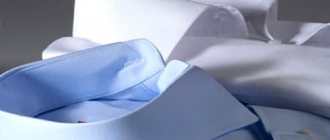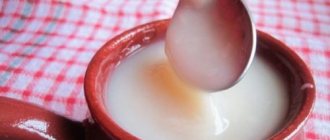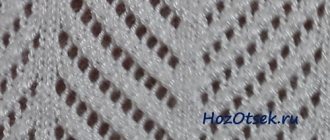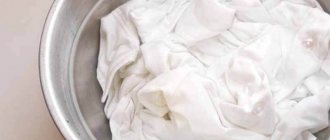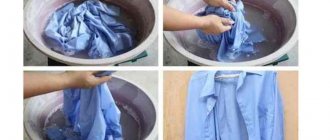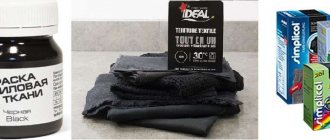Beautiful and neat tulle gives your home interior a cozy and warm atmosphere. In addition to washing, something as simple as starch allows you to keep your curtains clean. Today, fewer and fewer housewives spend time on this. Many people no longer remember how to starch tulle. However, a simple procedure not only gives the curtains an aesthetic and neat appearance, but also has practical value.
Classic method of starching with starch
You can starch things in different ways. The use of potato, rice, wheat, and corn starch remains classic. This method is suitable for white items. You can starch manually, using an automatic machine or by ironing.
Manually
Small fabrics, lace, and individual items of clothing are best handled by hand. This makes it easier to control concentration and process. The steps are the same for all types of fabrics. The only difference is the exposure time and the concentration of the paste.
Preparing solution and clothing
If possible, remove stains using ready-made stain removers or cheap improvised products. Light yellowish stains can be left: they will whiten in the process.
Items are pre-washed and bleached
When the items are washed and dried, prepare the starch. Using the information from the table above, calculate the required amount of warm water and powder for the required volume of clothing. The larger the fabric, the more water and starch will be required.
How to dilute starch for starching step by step:
- Place the powder in a saucepan.
- Fill with some of the prepared water.
- Mix thoroughly so that there are no lumps left in the mixture.
- If dense lumps form, pass the paste through gauze and squeeze out.
- Boil the remaining water.
- While stirring, pour the paste into the boiling liquid.
- Stir and remove from heat.
Boil the cloudy and viscous mixture for another five minutes or dilute with hot water. As soon as the mixture has cooled to 60–50°C, begin the starching procedure.
To give extra strength to the fabric during hard starching, add borax. It increases viscosity. Mix 15 g of the substance with a glass of hot water. Cool slightly and pour in after the paste when preparing a concentrated solution. Stir and leave to swell for two hours. Stir the fabric again before immersing it.
Details about the technology of whitening clothes with hydrogen peroxide at home
Starching process
Place the laundry in the cooled mixture and soak completely. Soak according to the desired effect: the longer the clothing is in the solution, the stiffer it becomes. The optimal time is five minutes. To make the laundry hard, keep it for 10–25 minutes.
For light starching, just leave for one minute.
Take the item out and push the moisture from top to bottom with your hands. Do not twist, otherwise there will be creases. Stretch or shape the product into the desired shape and leave it to dry in the room.
Advice. If you have no experience in starching, practice on unnecessary pieces. Keep it in different concentrations for different amounts of time to understand exactly how to achieve the desired effect.
In the typewriter
The machine is convenient for starching bulky fabrics: pillowcases, sheets, tulle, curtains. No powders or conditioners are added.
How to do:
- Weakly brew the starch or dilute the thick paste with warm water.
- Pour the mixture into the conditioner compartment.
- Turn on the appropriate mode for the fabric type.
- After completing the cycle, remove and hang so that no wrinkles form.
It is important to use a weak solution, otherwise the viscous paste will clog the machine parts. If the laundry is not hard enough, repeat the steps.
After the procedure, wipe the drum and door with a damp cloth. Wipe dry.
If you use starch frequently, do not forget to periodically clean the inside of the machine, for example, with citric acid.
When ironing
The method is not suitable for napkins, tablecloths, cuffs and silk items.
Using this method, you can lightly starch a shirt and starch individual items of clothing.
How to proceed:
- Make a weak solution for soft starching.
- Pour the liquid into a spray bottle.
- Spray the area of clothing and cover with a thin natural cloth.
- Iron.
The fabric is needed to prevent carbon deposits from forming on the iron. Instead of a home remedy, use ready-made aerosols, for example, Yplon Expert or Luxus “Superforma”. According to reviews, some products leave yellow stains, so test on an inconspicuous area before use.
Finishing without starch
The same effect can be achieved using other available products and special store-bought formulations. These preparations are suitable for synthetic curtains that are not affected by potato starch. It is better to coat materials with synthetic threads with special production mixtures or gelatin.
Sugar
The finishing solution is prepared in the following way:
- Dissolve 5 tbsp in a liter of boiling water. spoons of sugar.
- Cool the liquid.
- Immerse the tulle in warm water.
- Wait until it is soaked, remove it and let the solution drain.
This method has some nuances. In particular, do not boil sugar in water, otherwise the solution will turn yellow and stain the curtains. Another disadvantage of this method is that curtains with the smell of sweet syrup will attract insects into the house.
Gelatin
First you need to prepare a solution. 3 tablespoons of gelatin should be dissolved in 50 ml of cold water. Then the liquid is heated in a water bath. Gradually another half liter of water is added to it. The resulting solution must be dissolved in 4-5 liters of warm boiled water and the curtains should be immersed in it. The method is well suited for synthetic fabrics.
PVA glue
In some cases, glue is used for finishing. To do this, dissolve two teaspoons of PVA in a bucket of warm water. This method evens out the texture of the fabric, making it smoother and shiny. After this treatment, dust does not settle on the curtains for a long time.
Silicate glue
It works in the same way as PVA. To prepare the solution, you need to dilute a teaspoon of glue in a bucket of water. The tulle is dipped into the liquid for a couple of minutes, then dried. The method is suitable for delicate fabrics.
Industrial products
Modern industry offers special sprays and powders for finishing. Some drugs are made on the basis of polyvinyl acetate emulsion.
Dry tulle can be starched using industrial aerosols. Such products are sprayed onto fabrics before ironing. Their advantage is that there are no streaks or light marks left on colored fabrics.
Instructions for performing the work
To quickly and efficiently glue tulle to the window, you need to study the instructions and follow them when performing work:
- The area where the tulle is supposed to be glued is measured with a centimeter, and the measurements are transferred to the material.
You can transfer the measurements to a layout (paper), cut it out, attach it to the window and check the correct dimensions, and then apply it to the fabric and cut out the lace as needed.
- The correctness of the cut material is checked by applying it to the original location.
- There are two ways to glue fabric:
- The paste is applied to the glass with a wide brush, a piece of tulle is applied and straightened, then another layer of glue is applied on top of the lace, waiting for complete drying.
- Place the glue in a wide bowl, gradually immerse the fabric, leave it for some time to soak, remove the tulle and get rid of excess paste by squeezing it out, stick it on the window, carefully smoothing it out, wait until it dries completely.
We invite you to watch the video instructions:
Why starch textiles and when not to do it
During the process of starching the fabric, its fibers are impregnated with polysaccharides. A thin film is formed on the surface of the threads, which increases their density and elasticity. As a result of starching, textiles hold their given shape well, bleach, crumple less and “creak” when touched. In addition, products stay clean longer and are easier to wash, since the starch film repels dirt and does not allow it to penetrate deeply into the fibers.
The disadvantage of starching is the fact that it reduces the breathability of the fabric. It is not recommended to process:
- summer clothes (it is advisable to starch only individual parts);
- underwear (they may become stiff and cause discomfort);
- dark products (starch can change their shade);
- synthetic fabrics (the solution is not fixed to their fibers);
- things embroidered with floss threads (they can stick together and lose their shine).
Pros and cons of decorating a window with glued tulle
The advantages of this procedure:
- Availability of materials.
- Ease of implementation. Even an inexperienced craftswoman can handle this work.
- Possibility to peel off the openwork fabric, replacing it with another one. To do this, soak the pasted material with a washcloth moistened with hot water. Once wet, it will easily come off the glass surface.
- Aesthetics and functionality. An openwork window not only looks beautiful, but also protects from the bright sun and prying eyes.
The only drawback of this method of decoration is the need to prepare the starch paste yourself. As noted earlier, synthetic glue is not recommended for use in this situation.
How to starch tulle in a washing machine?
Tulle is a translucent protection of our home from the sun and an important interior detail that creates a positive mood and a cozy atmosphere. Tulle is most often made from fibers of various origins: silk, viscose, polyester or cotton. Experts recommend washing tulle three to four times a year to avoid the appearance of a gray tint. Nowadays, an automatic washing machine is an indispensable assistant in the fight for cleanliness. But how to starch tulle at home in an automatic washing machine? First, you need to prepare an adhesive solution, as described above. Before starting the washing machine, dilute the paste with water and pour it into the rinse aid compartment. Turn on the washing machine. After stopping, remove the tulle from the drum, shake it and hang the still wet tulle on the curtain rods.
There is an even simpler option. Instead of homemade paste, you can use special products with a starch effect. Read the instructions for these products carefully and everything will be fine. Read times: 6,784 Today: 1
Examples of lace windows
Glass covered with openwork fabric has its own unusual flavor. They radiate warmth and comfort. Beautiful patterns decorate the glass not only from the inside, but also from the outside. At the same time, the material transmits light well inside. But at the same time it protects from overly aggressive rays of the sun and the curious glances of passers-by. For those who want to try to put an unusual idea into practice, photos of lace windows will help. They show how interesting and unusual the romantic patterned decor looks.
If you decorate the glass with tulle, not only the window will be transformed. The entire interior of the room will be different. Designers advise combining the openwork on the glass with other objects in the interior. For example, you can duplicate the openwork inserts on the buffet doors or cover the table with a patterned tablecloth. You can also sew pillows from guipure or cover the frame of a floor lamp. It all depends on the style of the room and the creative imagination of its owners.
Bleaching curtains
Sometimes even after thorough washing, yellowness, soot and traces of soot remain on the fabric. In this case, strong stain removers and bleaching agents are used. Frequent use of chemical liquids negatively affects the quality of the fabric, thinning the fibers. Curtains get dirty faster and lose their shape. Synthetic tulle and dyed cotton cannot withstand bleaching.
In the washing machine
To make the fabric snow-white, bleach is added to a special compartment of the machine. Do not use chlorine-containing products. Their aggressive substances damage the thin fibers of the material. Suitable for curtains:
- Oxygen bleaches - used for colored and white materials. Effective in low-temperature washing modes, do not destroy texture and color.
- Optical brighteners - lighten canvases well, restoring their original whiteness. Used only for white tulle.
Popular brands designed for bleaching delicate fabrics and tulle:
- HEITMANN is a detergent for washing curtains, except for silk items. Special salt breaks down dirt, nicotine and yellow deposits, and removes the gray tint.
- Snow-white linen is an oxygen bleach without chlorine, fragrances, dyes and phosphates. Gently washes lace tulle and helps maintain whiteness for up to 60 days.
- Frau Schmidt “Super White Tulle” - restores the white color of curtains, suitable for voile and muslin.
- Pilot Tulle - whitens, removes stubborn plaque and unpleasant odors.
- DYLON - adds dazzling whiteness to faded tulle.
- Dr. Beckmann - removes dirt, grayness and yellowness from the surface of fabric.
- Major Domus - restores the perfect appearance of curtains, without chlorine, has an antifungal effect.
Home methods
Simple home remedies can easily eliminate the dullness of the material and improve the appearance of transparent tulle. Safe and effective whitening methods:
- Zelenka. Add 10 drops of solution to a glass of cold water and leave for 5 minutes. Mix the resulting liquid well and pour into the basin during the last rinse. Rinse the tulle thoroughly under running water.
- Potassium permanganate. A solution of bright, rich color is prepared in a glass, then poured into a container of water. The tulle is rubbed with laundry soap and soaked in potassium permanganate for 30 minutes. After time, the fabric can be washed using any chosen method.
- Blue. You can whiten a curtain using blue pigment. It is added to clean water to create a bluish tone. The tulle is carefully rinsed for five minutes. To evenly bluish the entire surface of the fabric, it is constantly turned over.
Useful tips
When gluing the material, you can use useful tips:
- Many people, in order not to bother with preparing glue, buy synthetic glue. What to do is not recommended. The use of synthetic material will lead to yellowing from sunlight, an unpleasant odor will be released, and it will make it difficult to dismantle the material.
- When preparing the paste, you need to obtain a medium consistency, otherwise a very liquid or thick consistency will complicate the gluing process.
- Use starch with increased whiteness, which will help avoid yellowing.
- When choosing fabric, avoid stains and thread ends.
- When applying glass dimensions to the tulle, you need to take into account allowances of about half a centimeter on each side (if you follow this advice, you will not need to unnecessarily stretch the fabric soaked in the solution).
- Work with rubber gloves (you can wear regular medical gloves), which will help keep the skin of your hands intact.
- If the surface consists of several openings, do not apply glue to each glass at the same time.
- If possible, select fabric of the required shade to match the color of the room.
- If you need to peel off the tulle, it won’t cause any problems. To do this, just use a washcloth with hot water. The washcloth is soaked in hot water, then applied gradually to the entire surface where the tulle is glued (the entire fabric should be well saturated). Wait a few minutes for the water to dissolve the glue. After which you can remove the material and wash the glass.
Finishing without starch
The same effect can be achieved using other available products and special store-bought formulations. These preparations are suitable for synthetic curtains that are not affected by potato starch. It is better to coat materials with synthetic threads with special production mixtures or gelatin.
Sugar
The finishing solution is prepared in the following way:
- Dissolve 5 tbsp in a liter of boiling water. spoons of sugar.
- Cool the liquid.
- Immerse the tulle in warm water.
- Wait until it is soaked, remove it and let the solution drain.
This method has some nuances. In particular, do not boil sugar in water, otherwise the solution will turn yellow and stain the curtains. Another disadvantage of this method is that curtains with the smell of sweet syrup will attract insects into the house.
Gelatin
First you need to prepare a solution. 3 tablespoons of gelatin should be dissolved in 50 ml of cold water. Then the liquid is heated in a water bath. Gradually another half liter of water is added to it. The resulting solution must be dissolved in 4-5 liters of warm boiled water and the curtains should be immersed in it. The method is well suited for synthetic fabrics.
PVA glue
In some cases, glue is used for finishing. To do this, dissolve two teaspoons of PVA in a bucket of warm water. This method evens out the texture of the fabric, making it smoother and shiny. After this treatment, dust does not settle on the curtains for a long time.
Silicate glue
It works in the same way as PVA. To prepare the solution, you need to dilute a teaspoon of glue in a bucket of water. The tulle is dipped into the liquid for a couple of minutes, then dried. The method is suitable for delicate fabrics.
Industrial products
Modern industry offers special sprays and powders for finishing. Some drugs are made on the basis of polyvinyl acetate emulsion.
Dry tulle can be starched using industrial aerosols. Such products are sprayed onto fabrics before ironing. Their advantage is that there are no streaks or light marks left on colored fabrics.
Other recipes
If using starch cannot be done, other techniques can be used to give the items strength.
Aerosol
This method is most often used if it is necessary to starch individual parts of clothing. To perform the technique, you need to dilute 2 teaspoons of powder in a liter of water. The resulting composition is simmered over low heat for 5 minutes, then cooled and sprayed with an aerosol.
Gloss-starch
It is used to ensure that things not only keep their shape, but also have an attractive shine. To prepare, you need to mix 3 tablespoons of starch (rice), half a teaspoon of borax, 2 tablespoons of talcum powder, 4 tablespoons of table water. A napkin is moistened with the resulting composition and the fabric is processed, which is then shaken off and ironed.
How to starch linen at home: relying on traditions
So, in front of you lies a whole stack of various textiles (blouses, napkins, bed linen, even a children’s school uniform) and the task is to starch it all. But how to solve it? After all, not every modern housewife even accurately understands the essence of the process, not to mention the preparation of the solution and methods of application.
READ MORE: Rating - review of safes for apartments - how to choose the best 2020
As the name suggests, the main substance here is starch. It has a number of properties that have a great effect on the appearance of the thing:
- Gives elasticity, any dress takes on the desired shape, the collar stands up, the tablecloth is smoothed out and lies flat on the table;
- Repels dirt. A starched product does not get dirty much longer, so in the past, snow-white parts of school uniforms were especially often starched;
- Whitens. Starch is considered a natural bleach, which, while coping well with its assigned task, practically does not spoil the fabric, having a soft, delicate effect;
- Extends the life of things. Starch contains substances that strengthen the fibers of the material. Properly starched clothes last much longer.
For such purposes, any food starch is used: potato, corn, rice and wheat. However, the first option is considered more suitable. Potato starch has a pure white color, does not leave stains or streaks, and thickens faster than all others.
Previously, every housewife knew the benefits of the procedure and not only ironed things, but also starched them. Moreover, at home, without the use of machines or automatic machines. Today, most people wear clothes that do not require this type of treatment. And yet, sometimes there is a need to turn to antiquity.
To understand how to starch things at home, you need to take into account the rule: there are several methods that differ in the severity of the impact on the material. For example, a coarse cotton tablecloth is treated completely differently than a thin, transparent tulle. And in order not to spoil, but to decorate the product, it is necessary to rely on its features.
Our mothers and grandmothers used the following methods:
- Soft. The method is suitable for the lightest, most delicate fabrics that are afraid of rough handling (the above-mentioned tulle, tulle, cambric, etc.). Solution recipe: 1 liter of water, half a teaspoon of starch (you can take the whole one). Mix thoroughly so that not a single lump remains. With this method, the item does not become hard to the touch.
- Medium hard. The composition is used to process shirts, models with flounces, lace, bows, school aprons, as well as tablecloths and napkins. Solution recipe: 1 liter of water 1 tablespoon of starch. Dilute until completely free of lumps.
- Hard. A method for thicker textiles, such as collars, cuffs, petticoats. For those cases when a certain clothing item needs to be given a standing shape and volume. The most important nuance: the composition must include borax (sodium boric salt), which enhances the effect. Solution recipe: 1 liter of water 2 tablespoons of starch. Stir thoroughly and add a teaspoon of borax, after diluting it. The mixture is infused for about two hours and only then used.
READ MORE: Rating of Internet providers in Novosibirsk - rating of the “Business Quarter”
Here are the main methods that helped our mothers and grandmothers keep their clothes clean and beautiful. However, if you think that the main difficulty lies in preparing the solution, you are mistaken. There are several requirements for a product that should be starched. It should be clean and dry, without stains.
When the solution is prepared, it is diluted with hot water. The correct mixture for starching has a viscous consistency, does not contain lumps, and is slippery to the touch. Correct volume: the product being processed is immersed entirely, each fiber is impregnated with the composition.
When the nuances are met, the product is carefully lowered into the solution and left until completely wet. Then they take it out, squeeze it out lightly, straighten out each fold, and dry it naturally.
Modern housewives are accustomed to using various machines that make life easier. Therefore, the question of whether it is possible to starch an item in a washing machine is quite natural. And the answer is encouraging: yes. You just need to know some secrets.
Let's see how to starch laundry in an automatic washing machine. And not only bedding, but also various other textile products.
How to properly starch tulle at home.
In the world of ideals, there are three ways to starch at home: soft, medium and hard. The tulle is softly starched. To do this, you must follow the following instructions. Take two tablespoons of starch and mix with cold water. Next, add warm water to the resulting solution and heat until a colorless sticky mass is obtained. Remember to stir the paste to avoid lumps. Then you need to add cold water and mix vigorously. Immerse the tulle in the resulting solution for thirty minutes. After squeezing, dry slightly and smooth out the still wet tulle.
Items treated with starch are always slightly different from simply washed items. Consequently, the smoothing process for these items becomes more accurate. When working with an iron, try to follow several rules:
Slightly damp starched items are easier to iron, so it is recommended to iron them only when damp. Products after starching must be ironed on both sides, starting from the inside out. Therefore, the iron should be heated to about 120-140 degrees Celsius. Starched fabric loses its beneficial qualities due to water, which means that steam should not be used when ironing.
Recommendations
The preparation of the paste and its quality have a direct impact on the adhesion of the material. The mixture must be free of lumps, otherwise it will negatively affect its adhesive properties.
After completion of work, the window should not be touched for 24 hours. At the same time, it is undesirable to ventilate the room. Before work, we recommend watching a video with a visual technique of work, so as not to make a mistake when gluing tulle:
Using curtains on windows visually reduces the size of the room. The solution to this problem is to glue tulle to the window. This method does not require large material costs or your own time. It will help transform the look of the room, there will be constant access to light, and will protect passers-by from unnecessary glances.
How to starch tulle at home
To make tulle look more advantageous, it should be starched after washing - as a result, the fabric will hold its shape better and accumulate less dust. You can do this quite simply yourself, without resorting to the services of special laundries.
To do this, you need to prepare a starch solution as follows:
- Dissolve two tablespoons of potato starch in 200 ml of cold water until a homogeneous cloudy liquid is obtained, which is then poured in a thin stream into a pan of almost boiling water. At this moment, you should actively work with a whisk to prevent lumps from forming.
- When bubbles begin to form on the surface of the contents of the dish, remove from the stove, strain and pour into cold water. Then rinse the tulle in the solution for two minutes.
- Once the moisture has drained from the fabric, iron the item while it is still damp.
Acceptable washing and bleaching products, folk remedies
The range of products for washing tulle is extensive. Considering the type of material, you can choose a product that will remove dirt, whiten and starch the fabric.
Shampoos and gels for delicate washing are used at temperatures from +30 to +40 °C. These preparations effectively remove dirt in cold water and are easily washed out when rinsing.
Children's powders and gels are less aggressive and do not cause allergies. Therefore, in addition to using curtains in the nursery for washing, they are used for washing tulle fabrics in the rooms of allergy sufferers.
Ordinary powders are attractive at a budget price. Select them according to the color of the textile, use according to the instructions on the packaging, and rinse the product thoroughly. To lighten tulle, it is worth choosing bleaches without chlorine in the composition, since it damages the material and turns the fabric yellow or green.
Among the popular compositions, recipes based on salt, ammonia, hydrogen peroxide, soda, brilliant green, and blue are popular.
We use blue
A small amount of blue is required to return the curtains to white. The substance is diluted with warm water in a separate container to a weak solution. The product is effective in the fight against yellowness.
Cleaning with brilliant green
The mixture is prepared from 0.5 liters of water, 2 tbsp. l. salt, 15 drops of brilliant green, mix it thoroughly
The solution is set aside for 3-4 minutes until a sediment forms, carefully filtered, leaving the grounds in the same container
The product is poured into water for final rinsing, where the washed curtains are placed for 3-4 minutes. During the rinsing process, the product should be rotated to achieve uniform lightening.
At the end, the curtains are lightly wrung out, without twisting, and hung to dry.
How to wash tulle with salt
To lighten and starch an item, follow these steps:
- Fill the basin with water.
- Add salt.
- Place the pre-washed curtain in this solution for a while.
- Rinse the curtain and dry.
How to wash tulle in a washing machine with soda
To remove stubborn dirt and lighten matter with soda, you will need:
- Mix 100 g of washing powder and 2 tbsp. l. baking soda.
- Pour the mixture into a container of warm water and stir.
- Soak the fabric in the solution for 20 minutes, then lightly wrinkle and squeeze, drain the water.
- Wash in washing machine.
- Rinse and dry the item.
Washing with hydrogen peroxide
Hydrogen peroxide in tandem with ammonia will help wash nylon tulle. Pour hot water (10 l) and 2 tbsp into the tank. l. ammonia and hydrogen peroxide, mix thoroughly with a wooden stick/spoon.
Be sure to read:
Why is oxygen bleach the best for white and colored laundry?
Freshly washed fabric should be placed in the prepared solution and kept for 15 minutes, then rinsed in warm water, hung over the bathtub to drain.
Then the curtain is hung on the window cornice, straightening the folds on it. Here the curtain will dry quickly.
We use vinegar
The curtain in the kitchen suffers the most from dirt and greasy stains. To remove traces of burning and grease on it, dissolve the washing powder in hot water, pour in vinegar in a proportion of 50 ml per 1 liter of water, add a few drops of detergent.
Wash the tulle curtain in the solution and leave it there for 30 minutes. After rinsing, the greasy residue will disappear, and the vinegar smell will disappear quickly.
Preparation for the procedure
Before you starch tulle or curtains at home, you need to clean them of dirt and stains. To do this, several stages of preparation for finishing are carried out.
Soak
The tulle is soaked in the cleaning solution for several hours. Add a tablespoon of soda or powder to 10 liters of warm water. Liquid laundry soap or table salt will also work. The solution can be changed several times depending on how severe the degree of contamination is.
Washing and bleaching
After soaking, you can start washing. Dissolve the powder in water. The temperature should not exceed 40-50 degrees. During the procedure, squeeze the fabric slightly, lifting it above the water and lowering it back into the container. Try not to rub the edges of the curtain against each other, this will ruin the quality of the tulle and lead to deformation of the fibers.
Not all fabrics are suitable for aggressive household chemicals. Since tulle is made from chiffon, cotton, nylon, organza and other airy materials, the detergent is selected individually, depending on the type of fabric. In addition to store-bought powders, there are a lot of cheap homemade bleaches.
| Material | How to wash and bleach | What to watch out for |
| Chiffon |
|
|
| Capron |
|
|
| Organza |
|
|
| Cotton |
| (unpretentious) |
| Veil |
|
|
Housewives face the greatest troubles when washing voile curtains. This thin material absorbs dust faster than others. To completely remove dust from it, a long soaking in the active composition is required.
You can bleach nylon curtains with regular table salt. This is a safe method. Such curtains can even be hung in the bedroom of a child with allergies. The only negative is the processing time. The tulle needs to be kept in the solution for 6 to 8 hours, so it is better to soak it overnight. The pre-washed curtain is placed in a bucket of water and 200 g of salt. In the morning, the material needs to be rinsed.
Rinsing
After washing and removing stains, the curtains are rinsed twice: in warm and cold water. The main thing is not to twist or squeeze the tulle. Otherwise, this will lead to deformation and rapid wear of the fabric.
Basic methods
When figuring out how to starch fabric with starch, you should know that the essence of the process is to soak the textile in a solution of plant materials and water. You can use a processed product from potatoes, corn, rice or wheat. The most commonly used starch is potato starch. It is inexpensive, gives things a bright white color and thickens well.
Before starching, the fabric should be washed and rinsed thoroughly. It may be wet or completely dry before being lowered into the solution. Depending on the concentration of the mixture, there are three processing methods:
- Soft. Allows you to give the product elasticity, but does not make it hard to the touch. Suitable for bed linen, blouses, dresses made of chiffon, cambric, silk.
- Average. Makes it possible to create a specific shape and refresh textiles. Used for tablecloths, napkins, men's shirts, furniture covers, curtains, lace, flounces.
- Hard. It is necessary if the question arises of how to starch the fabric so that it stands. Used for petticoats in fluffy dresses, cuffs, collars, decorative textile flowers.
In addition, the starching effect can be achieved without the use of starch. Gelatin, sugar and glue are used for these purposes.
Soft method for bed linen and tulle
When solving the problem of how to starch linen, we will consider in detail the soft processing method. The solution is prepared at the rate of 1 teaspoon of starch and 1 liter of water.
Stages:
- Pour starch into a small container and add 150-200 ml of cold water. Stir thoroughly so that there are no lumps.
- Boil the rest of the water. Pour in the concentrated starch solution while stirring constantly. Turn off the fire.
- Cool the liquid to room temperature. It should be transparent and leave a slippery mark on the skin if you put your hand into it.
- Pour the starch solution into a basin and immerse the bed linen in it for 1-2 minutes to soak it.
- Remove the fabric, wring it out and shake it off. Hang to dry. If possible, remove all creases and folds.
In addition, a soft solution can be used if a problem arises, how to starch tulle or curtains to make them look more elegant.
Stages:
- Combine starch with water according to the scheme described above.
- Immerse the tulle in the cooled solution for 30 minutes.
- Pull out the fabric. Squeeze out the liquid.
- Iron the tulle when it is slightly dry but still damp.
Middle method for lace, napkins, shirts, school aprons
A medium-hard starch solution is made from 1 liter of water and 1 tablespoon of raw materials. The process of preparing the mixture is similar to the previous method. The result is a translucent, homogeneous liquid “jelly”. If the solution is too thick, add a little warm water to it and stir thoroughly.
The further algorithm of actions depends on the type of fabric. It is enough to dip tulle and other thin materials in starch liquid for a few seconds, lace and openwork napkins - for 20 minutes, tablecloths, table napkins and shirts - for 10-15 minutes.
If you need to starch a separate piece of clothing (ruffles, lace), you can prepare a solution and lubricate the decor with it using a piece of fabric or a sponge. After 10-15 minutes, the treated fragment should be covered with gauze and ironed with a warm iron.
Hard method for gauze, collars, cuffs
Let's figure out how to starch fabric heavily at home so that it holds its shape well. The solution can be prepared according to the previously described algorithm from 1 liter of water and 2 tablespoons of starch, or use another recipe.
Components:
- 1 liter of water;
- 50 g starch;
- 1 teaspoon of borax, that is, sodium boric salt, which can be bought at the pharmacy.
Preparation of a solution for hard starch:
- Dissolve starch in a glass of cold water.
- Dissolve borax in a glass of hot water. Cool to room temperature.
- Boil the remaining water. Stirring constantly, pour the starch into it.
- Add borax solution to the starch jelly. Wait 2 hours.
Let's look at how to starch gauze if a petticoat is made from it, and you want it to add fluffiness to the dress:
- Dip the product into the starch solution.
- As soon as the fabric is completely saturated, pull it out, wring it out and let it dry slightly.
- Iron the gauze, straightening out the folds while it is wet.
To starch the cuffs and collar of a shirt, only these elements need to be dipped into the solution. After 20 minutes, they should be taken out, squeezed out, dried and ironed thoroughly.
What kind of tulle can be glued to glass?
The choice of material is an important step. It all depends on the purpose of designing the window bay and the quality characteristics of the canvas:
- Lightweight fabric is optimal. Tight cuts will not last long on a slippery surface and will fall off under their own weight.
- The web made of synthetic and natural silk fibers is quite strong and delicate. Often the patterns repeat the pattern of snowflakes. Looks good on windows in rooms with light walls.
- Guipure or machine-knitted tulle emphasize the sophistication of the interior. But handmade samples are too heavy for glass.
- Gluing old transparent curtains fits into the “country” and “Provence” styles.
It is not necessary to buy snow-white fabric. Inserts with colored patterns look interesting on windows. It is not difficult for craftsmen who have mastered the method to create real stained glass windows.
Different types of fabric
Before starching an item, you need to determine what type of fabric you are dealing with.
Each material has its own characteristics that are important to consider
Canvas
Those who love to embroider are probably wondering how to starch canvas. Some needlewomen use a special spray for this purpose, as it is very convenient. But here we will also look at the classic method.
Pour two tablespoons of any starch into a liter of water and mix. Dip the canvas into the solution and let it soak thoroughly, then lay it out on a flat surface, leaving it to dry completely. The next step will be ironing, but before it you need to lightly spray the canvas with clean water from a spray bottle.
It is advisable not to starch the finished embroidery, as the floss threads will stick together and lose their shine. But if you really need it, then it’s best to spray it on the underside with a weak solution from the same spray bottle.
Gauze
You don’t often have to think about how to starch gauze. This is usually done in order to give the carnival costume splendor and a certain shape. And if so, you should resort to hard starching (the preparation of the solution and the method itself have already been described above).
Tulle, muslin, chiffon, guipure and lace
How to starch clothes made from light and translucent fabrics? The answer in this case will be ambiguous. If a chiffon or guipure blouse fits too tightly to the body, then starching it is not recommended at all.
To give shape to decorative elements, for example, a child's lace crown, the rigidity should be maximum. In other cases, the medium or soft method is used. They are exactly the same as hard, only less starch is added to the solution (soft - 1 teaspoon, and medium - 1 tablespoon per liter of water).
To give decorative elements increased rigidity, a high concentration starch solution is used.
